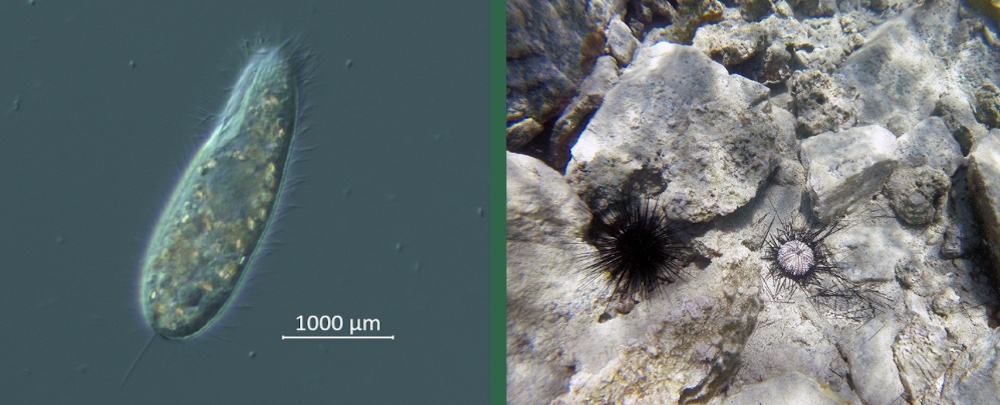By Kristen Kusek, USF College of Marine Science
Media assets, including photos and B-roll, are available here. Story is also availabe En Español.
The search for the 2022 killer that decimated long-spined sea urchins in the Caribbean and along Florida’s East coast is over. A team of scientists-turned-sleuthhounds organized by Mya Breitbart, Distinguished University Professor at the University of South Florida’s College of Marine Science, identified the small-but-mighty offender: a single-celled organism called a ciliate. They reported the results in Science Advances.
Since last year, all eyes have been on the long-spined sea urchins (Diadema antillarum) – those that are left, that is. They inhabit shallow tropical waters and feed on algae that would otherwise destroy a reef. The animals began to literally lose their spines within days, and die in droves in January 2022, sparking an all-hands-on-deck effort to figure out why. The urchin graveyard began in the U.S. Virgin Islands and stretched for thousands of miles between the Caribbean and east coast of Florida.
A similar die-off event took place in the early 1980s, which wiped out 98 percent of the long-spined sea urchin population. The Diadema community was still recovering 40 years later. The culprit of that die-off remains a mystery.
“We’re beyond thrilled to get to the bottom of the 2022 mystery and a bit stunned we did it so quickly,” said Breitbart, senior author on the Science Advances study and expert in marine genomics. “We had a great team in place and the tools we needed to do the ocean science equivalent of a forensic investigation.”
In total, it took the team four months to figure it out.

LEFT: Ciliate culture viewed under the microscope. [Photo by Makenzie Kerr, USF College of Marine Science.] RIGHT: Disease-affected sea urchin on the right next to a healthy sea urchin. [Photo by Ian Hewson, Cornell University.]
Several others were instrumental in the effort, including scientists from the University of Florida, Florida Fish and Wildlife Conservation Commission and organizations throughout the Caribbean. The team’s work was bolstered by a citizen-science effort to report dying urchins that was spearheaded by the Atlantic and Gulf Rapid Reef Assessment (AGGRA) team and the efforts of scientists from affected areas that collected healthy and sick urchins for analysis.
“That call in March from Mya quickly changed my end-of-winter plans,” said Hewson, who would trade winter boots for snorkeling fins, flying from New York to the Caribbean Islands to observe the situation up close. Hewson is an expert in diseases that cause mass die-offs of sea stars. He played a key role in designing the urchin team’s science protocol. “At the time we didn’t know if this die-off was caused by pollution, stress, something else – we just didn’t know.”
Examining urchins collected from 23 sites in the Caribbean, the team used a series of genomic and pathological techniques to confirm it was a ciliate that slayed the urchin population.
Ciliates are covered in hair-like structures called cilia that help them move and eat. They are found almost anywhere there is water; most are not disease-causing agents, but this one is. It’s a specific kind called a scuticociliate, hence the hefty name the team gave the disease: D. antillarum scuticociliatosis (DaSc).
The ciliate has been implicated in die-offs of other marine species, such as sharks, but it’s a first for urchins.
After identifying the ciliate using genomic techniques, the team grew it in the lab and performed infection experiments at the USF College of Marine Science in St. Petersburg. When the pathogen was introduced to otherwise healthy urchins in an aquarium tank, the urchins died within a few days – just as they did in the ocean. That sealed the deal for confirming the killer.
“We’re excited to share this information with everyone, from reef managers to more scientists so we can explore it further and try to stop its spread,” said Breitbart.
While thrilled with what they do know, the team’s list of remaining questions is long. For example:
- Is this ciliate new to the area, or was it there prior to the die-off?
- If it’s been there, what environmental conditions favored its growth and why did it infect the urchins?
- Can it affect other species of urchins?
- Is it present in the environment when urchins aren’t around?
“One theory we have is that the ciliate grew well under high-productivity conditions that were observed in the Caribbean when the die-off first started,” said Kellogg. “We’re also curious about the fact that there is some overlap in some geographic areas where this die-off occurred and where corals are declining from stony coral tissue loss disease.”
One thing is clear: no one benefits from a spineless sea urchin.
The work was funded by the National Science Foundation, Atkinson Center for Sustainable Futures Rapid Response Award, AGGRA, the National Oceanic and Atmospheric Administration, National Fish and Wildlife Foundation, Florida Keys Marine Sanctuary, and the Florida Fish and Wildlife Conservation Commission.